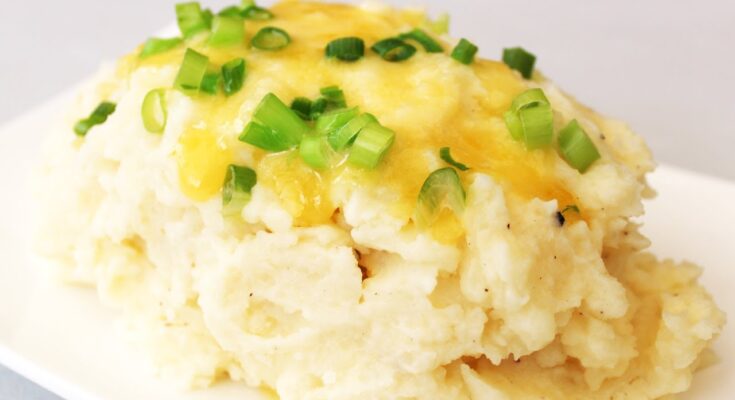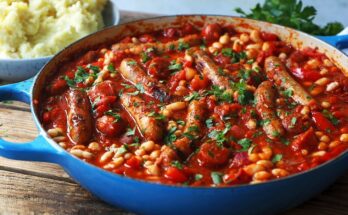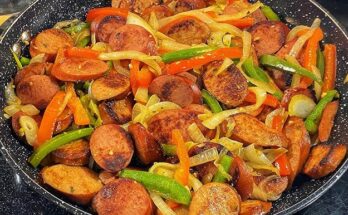Mashed Potatoes Recipe: Nothing beats the creamy, buttery goodness of freshly made mashed potatoes.
It’s a versatile side dish that can pair with just about anything — from a classic roast to Thanksgiving turkey. While mashed potatoes seem simple, there are a few tricks to getting them perfect every time.
This guide will walk you through each step so that you can whip up mashed potatoes that are smooth, fluffy, and full of flavor.
Ingredients Needed for Mashed Potatoes
Before we dive into the steps, let’s first gather everything we need.
Common Ingredients:
- 2 lbs of potatoes (Yukon Gold or Russet)
- ½ cup of unsalted butter
- ¾ cup of whole milk (or cream for extra richness)
- Salt to taste
- Pepper to taste
Optional Ingredients for Extra Flavor:
- 3 cloves of garlic (for garlic mashed potatoes)
- Fresh herbs like parsley, chives, or thyme
- Grated cheese (cheddar or parmesan)
- Sour cream for tangy creaminess
Choosing the Right Potatoes
The key to perfect mashed potatoes starts with picking the right variety.
Best Varieties of Potatoes for Mashing:
- Yukon Gold: These potatoes have a buttery flavor and creamy texture that makes them ideal for mashing.
- Russet Potatoes: These are starchy, resulting in light and fluffy mashed potatoes.
Why the Potato Type Matters
Waxy potatoes like red or fingerling varieties can result in dense or gluey mashed potatoes because they hold too much moisture. Stick with starchy or all-purpose potatoes for the best results.
Preparing the Potatoes
Once you’ve chosen your potatoes, it’s time to prep them.
Peeling vs. Leaving the Skin On
- Peeling: If you want ultra-smooth mashed potatoes, peel the potatoes before cooking.
- Leaving Skin On: For a more rustic mash, you can leave the skins on. Just be sure to wash them well.
How to Cut the Potatoes
Cut your potatoes into evenly-sized chunks (about 1-2 inches). This ensures they cook evenly.
Boiling the Potatoes
Place the potatoes into a large pot and cover them with cold water.
Correct Water Temperature and Salt
Always start with cold water when boiling potatoes. Add a generous pinch of salt to the water to season the potatoes from the inside as they cook.
How Long to Boil Potatoes
Bring the water to a boil and then reduce to a simmer. Cook the potatoes for about 15-20 minutes, or until they are tender when pierced with a fork.
Draining the Potatoes
Once the potatoes are tender, drain them well.
Why It’s Important to Drain Well
Excess water can make your mashed potatoes watery and thin. After draining, let the potatoes sit in the pot for a few minutes to allow any remaining moisture to evaporate.
Letting the Potatoes Steam for Maximum Fluffiness
To achieve fluffier mashed potatoes, return the drained potatoes to the pot and let them steam dry for a few minutes over low heat.
Mashing the Potatoes
Now comes the fun part — mashing!
Tools You Can Use to Mash
- Potato Masher: For a rustic, chunkier texture.
- Ricer: Produces super smooth and fluffy mashed potatoes.
- Electric Mixer: Use sparingly! Over-mixing can result in gluey potatoes.
How to Mash Without Overworking the Potatoes
Mash gently and avoid over-mashing, which can break down the starches too much, leading to a gluey texture.
Adding Butter and Milk
Best Types of Butter and Milk to Use
For the best flavor, use high-quality unsalted butter and whole milk or cream. Warm the milk before adding it to the potatoes to keep everything hot and prevent a gummy texture.
How to Achieve the Perfect Consistency
Start with adding half of the milk and butter, then slowly incorporate more until you reach your desired consistency. Stir gently to combine.
Seasoning Your Mashed Potatoes
Seasoning is crucial to achieving that restaurant-quality flavor.
Salt, Pepper, and Other Seasonings to Add
Start with salt and pepper, then taste and adjust. You can also add garlic powder, fresh herbs like parsley or chives, or a dash of paprika for extra depth.
Taste and Adjust for Perfection
Remember to taste as you go! Potatoes can absorb a lot of seasoning, so don’t be shy about adding more salt or pepper if needed.
Optional Mix-Ins
To make your mashed potatoes stand out, consider adding a few extra ingredients.
Adding Garlic, Cheese, or Herbs
- Garlic: Roast or sauté garlic cloves and mash them into the potatoes.
- Cheese: Stir in sharp cheddar, parmesan, or cream cheese for extra richness.
- Herbs: Fresh herbs like parsley, thyme, or rosemary can add a fresh, vibrant flavor.
Creating Gourmet Mashed Potatoes
For a gourmet twist, add truffle oil, caramelized onions, or even bacon bits to elevate your dish.
Making Mashed Potatoes Creamier (If Needed)
If your mashed potatoes turn out too dry, don’t worry!
Fixing Dry or Lumpy Potatoes
You can fix dry potatoes by adding more warmed milk or butter. If they’re lumpy, try passing them through a ricer or sieve for a smoother texture.
Serving Suggestions
Mashed potatoes are a classic side dish that pairs well with many meals.
Best Dishes to Serve with Mashed Potatoes
- Roast chicken or turkey
- Grilled steak or pork chops
- Meatloaf or beef stew
- Gravy (of course!) for added richness
Storing Leftover Mashed Potatoes
How to Store Properly
Store leftover mashed potatoes in an airtight container in the fridge for up to 3 days.
How to Reheat Without Losing Texture
To reheat, gently warm the potatoes on the stovetop or in the microwave, adding a splash of milk to restore their creamy consistency.
Common Mistakes to Avoid
Making mashed potatoes may seem straightforward, but here are a few pitfalls to watch out for:
- Overworking the Potatoes: This can make them gummy.
- Using Cold Butter or Milk: Cold ingredients can cool down your potatoes and make them heavy.
- Not Seasoning Enough: Potatoes need plenty of seasoning to bring out their flavor.
FAQs about Mashed Potatoes Recipe
1. What are the best potatoes for making mashed potatoes?
For the fluffiest and creamiest mashed potatoes, Yukon Gold or Russet potatoes are your best bets. Yukon Golds have a naturally buttery taste and smooth texture, while Russets are starchy, helping to create that classic fluffy texture.
2. Should I peel the potatoes before boiling them for mashed potatoes?
Peeling potatoes before boiling is a matter of personal preference. For smoother mashed potatoes, peel them beforehand. If you prefer a more rustic texture with a bit of skin, you can leave the peel on.
3. How much butter and milk should I use for mashed potatoes?
A good rule of thumb is to use about 1/4 cup of butter and 1/2 cup of milk for every 2 pounds of potatoes. Adjust the amounts to suit your taste and desired creaminess.
4. How can I make vegan mashed potatoes?
To make vegan mashed potatoes, substitute the butter and milk with vegan alternatives such as plant-based butter and almond, soy, or oat milk. You can also add richness with a splash of olive oil or vegan cream.
5. Can I make mashed potatoes ahead of time?
Yes, you can prepare mashed potatoes ahead of time. After making them, let them cool completely, then store them in the refrigerator in an airtight container. Reheat in a pot over low heat, stirring occasionally, and add a bit more milk or butter if needed.
6. What can I add to my mashed potatoes to give them more flavor?
Consider mixing in garlic, cheese, chives, or bacon for added flavor. Sour cream, cream cheese, or a dash of mustard can also enhance the taste and texture of your mashed potatoes.
Conclusion
There you have it — the ultimate guide to making perfect mashed potatoes every time. With just a few simple steps, you can transform humble potatoes into a creamy, flavorful dish that will impress your family and friends. Whether you keep them simple or mix in your favorite flavors, mashed potatoes are a timeless comfort food that’s always a hit.



